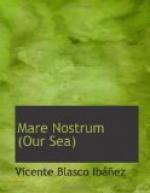In Glasgow he embarked as second mate on an old sailing tramp that was bound for Chile, to unload coal in Valparaiso and take on saltpeter in Iquique. The crossing of the Atlantic was good, but upon leaving the Malvina Islands the boat had to go out in the teeth of a torrid, furious blast that closed the passage to the Pacific. The Straits of Magellan are for ships that are able to avail themselves at will of a propelling force. The sailboat needs a wide sea and a favorable wind in order to double Cape Horn,—the utmost point of the earth, the place of interminable and gigantic tempests.
While summer was burning in the other hemisphere, the terrible southern winter came to meet the navigators. The boat had to turn its course to the west, just as the winds were blowing from the west, barring its route.
Eight weeks passed and it was still contending with sea and tempest. The wind carried off a complete set of sails. The wooden ship, somewhat strained by this interminable struggle, commenced to leak, and the crew had to work the hand-pumps night and day. Nobody was able to sleep for many hours running. All were sick from exhaustion. The rough voice and the oaths of the captain could hardly maintain discipline. Some of the seamen lay down wishing to die, and had to be roused by blows.
Ulysses knew for the first time what waves really were. He saw mountains of water, literally mountains, pouring over the hull of the boat, their very immensity making them form great slopes on both sides of it. When the crest of one broke upon the vessel Ferragut was able to realize the monstrous weight of salt water. Neither stone nor iron had the brutal blow of this liquid force that, upon breaking, fled in torrents or dashed up in spray. They had to make openings in the bulwarks in order to provide a vent for the crushing mass.
The southern day was a livid and foggy eclipse, repeating itself for weeks and weeks without the slightest streak of clearing, as though the sun had departed from the earth forever. Not a glimmer of white existed in this tempestuous outline; always gray,—the sky, the foam, the seagulls, the snows.... From time to time the leaden veils of the tempest were torn asunder, leaving visible a terrifying apparition. Once it was black mountains with glacial winding sheets from the Straits of Beagle. And the boat tacked, fleeing away from this narrow aquatic passageway full of perilous ledges. Another time the peaks of Diego Ramirez, the most extreme point of the cape, loomed up before the prow, and the bark again tacked, fleeing from this cemetery of ships. The wind shifting, then brought their first icebergs into view and at the same time forced them to turn back on their course in order not to be lost in the deserts of the South Pole.
Ferragut came to believe that they would never double the Cape, remaining forever in full tempest, like the accursed ship of the legend of the Flying Dutchman. The captain, a regular savage of the sea, taciturn and superstitious, shook his fist at the promontory, cursing it as an infernal divinity. He was convinced that they would never succeed in doubling it until it should be propitiated with a human offering. This Englishman appeared to Ulysses like one of those Argonauts who used to placate the wrath of the marine deities with sacrifices.




